Themed collection Journal of Materials Chemistry C Emerging Investigators

Journal of Materials Chemistry C profiles: Contributors to the Emerging Investigators 2017 Issue
Journal of Materials Chemistry C profiles contributors to the Emerging Investigators issue.

J. Mater. Chem. C, 2017,5, 5565-5571
https://doi.org/10.1039/C7TC90083J
The rise of organic magnetoresistance: materials and challenges
This paper provides a brief review of recent progress regarding the magnetoresistive effect observed in organic semiconductors.

J. Mater. Chem. C, 2017,5, 5572-5580
https://doi.org/10.1039/C6TC04403D
Layer-controlled two-dimensional perovskites: synthesis and optoelectronics
Solution-processed layered-controlled 2D metal halide perovskites are emerging as one of the most promising candidates for low-cost photovoltaics and optoelectronics.
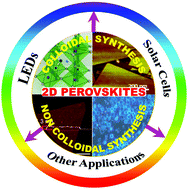
J. Mater. Chem. C, 2017,5, 5610-5627
https://doi.org/10.1039/C7TC00538E
Beyond traditional light-emitting electrochemical cells – a review of new device designs and emitters
This review provides a general overview about the definition, history and mechanism, as well as in depth summary of new emitters and designs for LECs.
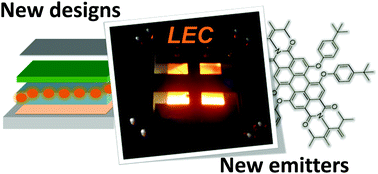
J. Mater. Chem. C, 2017,5, 5643-5675
https://doi.org/10.1039/C7TC00202E
Light-directed growth of metal and semiconductor nanostructures
This Review article explores the use of illumination to direct the growth of metal and semiconductor nanostructures.
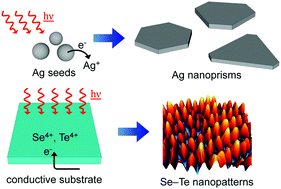
J. Mater. Chem. C, 2017,5, 5628-5642
https://doi.org/10.1039/C7TC00379J
Host–guest composite organic microlasers
In this Review, we present the recent progress in the field of host–guest composite organic micro/nanoscale lasers, and provide our perspective on the future research interests in this area.
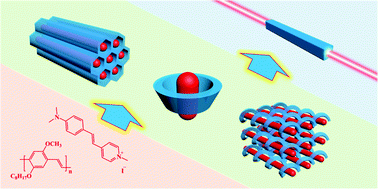
J. Mater. Chem. C, 2017,5, 5600-5609
https://doi.org/10.1039/C6TC05474A
Nanoporous anodic alumina photonic crystals: fundamentals, developments and perspectives
The control of light – its coupling, splitting, modulating, and filtering – is of fundamental importance for the development of advanced, life-changing technologies, which are expected to revolutionise our society in the near future.

J. Mater. Chem. C, 2017,5, 5581-5599
https://doi.org/10.1039/C6TC05555A
Synthesis of formamidinium lead halide perovskite nanocrystals through solid–liquid–solid cation exchange
Hybrid organic–inorganic formamidinium lead halide perovskite nanocrystals can be synthesized through a solid–liquid–solid cation exchange reaction.

J. Mater. Chem. C, 2017,5, 5680-5684
https://doi.org/10.1039/C7TC00598A
The excited-state intramolecular proton transfer properties of three imine-linked two-dimensional porous organic polymers
The excited-state intramolecular proton transfer (ESIPT) properties of three tris(N-salicylideneaniline)-based (TSA) imine-linked porous organic polymers (POPs) were investigated.

J. Mater. Chem. C, 2017,5, 5676-5679
https://doi.org/10.1039/C7TC00123A
Infrared electrochromic conducting polymer devices
Metal-free, flexible infrared electrochromic devices were fabricated using PEDOT:Tos as both the electrochromic and the electrode material, enabling modulation of the devices' infrared signature and their effective temperature as seen by a thermal camera. In addition to evaluating the practical suitability of these devices, we report a detailed investigation of the thin film spectroscopic properties.

J. Mater. Chem. C, 2017,5, 5824-5830
https://doi.org/10.1039/C7TC00257B
Matching precursor kinetics to afford a more robust CVD chemistry: a case study of the C chemistry for silicon carbide using SiF4 as Si precursor
We show by a combination of experiments and gas phase kinetics modeling that the combinations of precursors with the most well-matched gas phase chemistry kinetics gives the largest area of homoepitaxial growth of SiC.

J. Mater. Chem. C, 2017,5, 5818-5823
https://doi.org/10.1039/C7TC00138J
To probe the performance of perovskite memory devices: defects property and hysteresis
A hybrid perovskite memory device with a decent set voltage has been successfully demonstrated, and the performance was correlated to the defect density and hysteresis-index of different perovskite films.
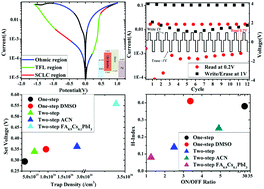
J. Mater. Chem. C, 2017,5, 5810-5817
https://doi.org/10.1039/C7TC00266A
Patterning and fluorescence tuning of quantum dots with haptic-interfaced bubble printing
Sub-micron resolution patterning and fluorescence tuning of CdSe/CdS quantum dots using haptic-interfaced bubble printing (HIBP) is reported.

J. Mater. Chem. C, 2017,5, 5693-5699
https://doi.org/10.1039/C7TC00454K
Ladder-type oligo(p-phenylene)s with D–π–A architectures: design, synthesis, optical gain properties, and stabilized amplified spontaneous emission
A novel family of D–π–A ladder-type oligo(p-phenylene)s with promising optoelectronic properties have been explored as gain media for organic lasers.

J. Mater. Chem. C, 2017,5, 5797-5809
https://doi.org/10.1039/C7TC00185A
Non-conventional synthesis and magnetic properties of MAX phases (Cr/Mn)2AlC and (Cr/Fe)2AlC
Mn- and Fe-doping of bulk MAX phase Cr2AlC was achieved by microwave heating and spark plasma sintering and non-trivial magnetism is discussed.
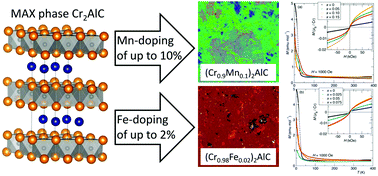
J. Mater. Chem. C, 2017,5, 5700-5708
https://doi.org/10.1039/C7TC00112F
Vapor phase organic chemistry to deposit conjugated polymer films on arbitrary substrates
Coating textured, high surface area substrates, such as paper and textiles, with conjugated polymer films is challenging.

J. Mater. Chem. C, 2017,5, 5787-5796
https://doi.org/10.1039/C7TC00293A
Structural design principles for low hole effective mass s-orbital-based p-type oxides
We demonstrate through first principles computations how the metal–oxygen–metal angle directly drives the hole effective mass (thus the carrier mobility) in p-type s-orbital-based oxides.
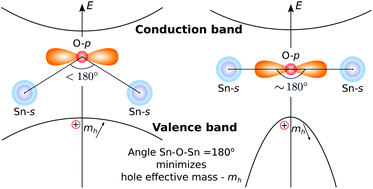
J. Mater. Chem. C, 2017,5, 5772-5779
https://doi.org/10.1039/C7TC00528H
Beyond binary: optical data storage with 0, 1, 2, and 3 in polymer films
The evergrowing amount of data created and collected is met with the increased need to store this data. By using a quaternary instead of binary code, data storage capabilities are vastly improved.

J. Mater. Chem. C, 2017,5, 5780-5786
https://doi.org/10.1039/C7TC00929A
Triblock near-infrared fluorescent polymer semiconductor nanoparticles for targeted imaging
Self-assembled nanoparticles of triblock copolymers incorporating a NIR-emitting fluorophore and folic acid specifically label folate receptor-positive cells.
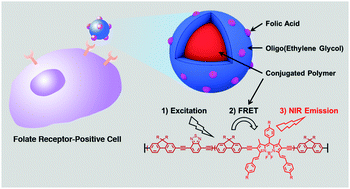
J. Mater. Chem. C, 2017,5, 5685-5692
https://doi.org/10.1039/C7TC00632B
The impact of aggregation on the p-doping kinetics of poly(3-hexylthiophene)
P3HT nanowhiskers are p-doped by F4-TCNQ faster than solubilized P3HT chains in toluene because of their highly ordered molecular packing.

J. Mater. Chem. C, 2017,5, 5764-5771
https://doi.org/10.1039/C7TC00189D
Charge carrier concentration dependence of ultrafast plasmonic relaxation in conducting metal oxide nanocrystals
The tunability of the localized surface plasmon resonances of doped metal oxides also impact their thermal relaxation.

J. Mater. Chem. C, 2017,5, 5757-5763
https://doi.org/10.1039/C7TC00600D
An oligocarbazole-encapsulated heteroleptic red iridium complex for solution-processed nondoped phosphorescent organic light-emitting diodes with over 10% external quantum efficiency
By fully encapsulating the heteroleptic red Ir complex with carbazole dendrons, solution-processed nondoped electrophosphorescent devices reveal over 10% EQE.

J. Mater. Chem. C, 2017,5, 5749-5756
https://doi.org/10.1039/C7TC00145B
Adsorption-controlled growth and the influence of stoichiometry on electronic transport in hybrid molecular beam epitaxy-grown BaSnO3 films
Adsorption-controlled growth and strong charge compensation accompanied by decreased electron mobility due to cation non-stoichiometry was discovered in epitaxial BaSnO3 films using a hybrid MBE approach.
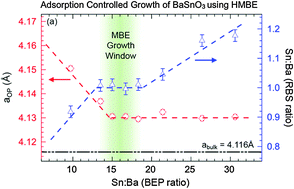
J. Mater. Chem. C, 2017,5, 5730-5736
https://doi.org/10.1039/C7TC00190H
An enhanced Seebeck coefficient and high thermoelectric performance in p-type In and Mg co-doped Sn1−xPbxTe via the co-adjuvant effect of the resonance level and heavy hole valence band
Remarkable enhancement of the Seebeck coefficient of an Sn rich Sn1−xPbxTe system due to the synergistic effect of resonance level formation and valence band convergence.

J. Mater. Chem. C, 2017,5, 5737-5748
https://doi.org/10.1039/C7TC00009J
Dynamic nature of excited states of donor–acceptor TADF materials for OLEDs: how theory can reveal structure–property relationships
In a theoretical study, we characterized the nature of the key excited states involved in the TADF process of donor–acceptor compounds and showed that light emission is enhanced by dynamic fluctuations of the donor–acceptor torsion resulting from flat torsional potentials.

J. Mater. Chem. C, 2017,5, 5718-5729
https://doi.org/10.1039/C6TC05075A
In situ identification of kinetic factors that expedite inorganic crystal formation and discovery
In situ X-ray diffraction reveals key processes that can be utilized to direct the synthesis of complex inorganic crystals.

J. Mater. Chem. C, 2017,5, 5709-5717
https://doi.org/10.1039/C6TC04931A
About this collection
Journal of Materials Chemistry C is proud to present this themed issue highlighting 2017’s rising stars of materials chemistry research. This issue gathers the very best work from materials chemists in the early stages of their independent career.
Each contributor was recommended by experts in their fields as carrying out work with the potential to influence future directions in materials chemistry. Congratulations to all of those who feature on their important work so far in the field of materials for optical, magnetic and electronic devices.